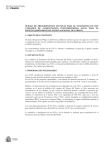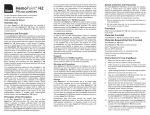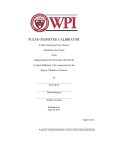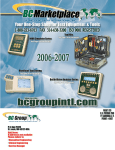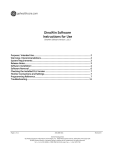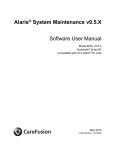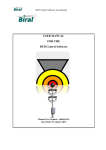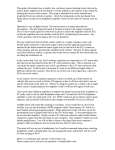Download 901-M / 901-ML
Transcript
901-M / 901-ML Pulse Oximetry System Technical Information and Service Manual CONTENTS 1. 2. PRELIMINARY REMARK ................................................................ ............................................................................... ............................................... 4 FUNCTION CTION DESCRIPTION................................ FUN DESCRIPTION ................................................................ ............................................................................ ............................................ 5 2.1. INTENDED USE .......................................................................................................5 2.2. CONTRAINDICATION.............................................................................................5 2.3. PRODUCT DESCRIPTION.....................................................................................5 2.4. THEORY OF OPERATION.................................................................................... 6 3. TECHNICAL DESCRIPTION DESCRIPTION OF THE 901901 -M/901M/901 -M L .................................... ....................................7 .... 7 3.1. DISPLAYS AND CONTROLS .................................................................................... 7 3.1.1. Front ................................................................................................................... 7 3.1.2. Back 901-M ........................................................................................................ 7 3.1.3. Back 901-ML ...................................................................................................... 8 3.2. CONNECTIONS ON THE UNIT............................................................................ 8 3.3. BLOCK DIAGRAM................................................................................................... 8 3.4. POWER SUPPLY.................................................................................................... 9 3.5. ON/OFF BUTTON ................................................................................................. 10 3.6. MASIMO BOARD .................................................................................................. 10 3.7. MICROPROCESSOR AND PERIPHERALS .................................................... 10 3.8. SELF-DIAGNOSTIC CAPABILITY OF THE 901-M/901-ML............................ 11 3.8.1. Watchdog and undervoltage reset ................................................................... 11 3.8.2. ROM check........................................................................................................ 11 3.8.3. RAM check ........................................................................................................ 11 3.8.4. Clock module check.......................................................................................... 11 3.8.5. Communication check with the Masimo board .............................................. 11 3.8.6. Operating voltage check...................................................................................12 3.8.7. Loudspeaker check ...........................................................................................12 3.8.8. Stack monitoring ..............................................................................................12 3.8.9. Detection of an uncontrolled reset ..................................................................12 4. MAINTENANCE PROCEDURES PROCEDURES ................................................................ ................................................................... ................................... 14 4.1. PRELIMINARY REMARK..................................................................................... 14 4.2. LI BATTERY REPLACEMENT............................................................................ 14 4.3. LIION BATTERY REPLACEMENT..................................................................... 14 5. POSSIBLE ERRORS AND THEIR CORRECTION .......................................... .......................................... 16 5.1. ERROR: SYSTEM ALARMS ............................................................................... 16 5.1.1. Hardware-related system alarms .................................................................... 16 5.2. ERROR: GREEN AC POWER LEDS DO NOT COME ON............................ 16 5.3. ERROR: 901-M/901-ML CANNOT BE SWITCHED ON IN BATTERY MODE .................................................................................................................................. 16 5.4. ERROR: 901-M/901-ML WILL NOT SWITCH ON IN MAINS MODE ........... 16 5.5. ERROR: YELLOW AND/OR RED ALARM LEDS DO NOT COME ON ....... 16 5.6. ERROR: FAULTY LOUDSPEAKER....................................................................17 5.7. ERROR: DISPLAY VALUES NOT PLAUSIBLE AND/OR FAULTY...............17 6. 901901-M/901M/901-ML CHECK ROUT ROUTINE OUT INE................................ INE ................................................................ ................................................................ 18 6.1. PRELIMINARY REMARK......................................................................................18 6.2. POWER SUPPLY CHECK....................................................................................18 2 6.3. 6.4. 6.5. 6.6. 6.7. 6.8. 7. 7.1. 7.2. 7.3. A. 8. 8.1. 8.2. 8.3. 8.4. DEVICE SELF-TEST AND BRIEF CHECK........................................................18 ALARM LIMITS CHECK ....................................................................................... 19 SENSOR ALARMS CHECK ................................................................................ 19 ACOUSTIC SIGNALS CHECK............................................................................20 DEVICE VALIDATION ..........................................................................................20 BRIEF CHECK .......................................................................................................20 SERVICE PROGRAM SERVICE901 SERVICE901 ............................................................... ............................................................... 21 PRELIMINARY REMARKS...................................................................................21 GENERAL INFORMATION ABOUT THE SERVICE901 .................................21 PERFORMING A PARAMETER UPDATE........................................................ 22 PERFORMING A SOFTWARE UPDATE.......................................................... 23 DATA DOWNLOAD PROGRAM DOWNLOAD901 ....................................... .......................................24 ....... 24 PRELIMINARY REMARK..................................................................................... 24 GENERAL INFORMATION ABOUT DOWNLOAD901 ................................... 24 DOWNLOADING DATA ....................................................................................... 24 SETTING TIME AND DATE................................................................................. 26 3 1. PRELIMINARY REMARK This technical information requires the knowledge of the 901-M/901-ML Instructions for Use manual. It is assumed that the operation and menu structure of the 901-M are known. In individual cases, it is necessary to use the Instructions for Use manual together with this technical information. 4 2. FUNCTION DESCRIPTION 2.1. Intended Use Continuous, non-invasive monitoring of the functional oxygen saturation of arterial hemoglobin (SpO2) and the pulse rate (measured by the SpO2 sensor) in adults, children, and neonates for use in hospitals, home care, for mobile or stationary applications. Monitoring may only be carried out with approved Masimo sensors. 2.2. Contraindication Disposable SpO2 sensors of the Masimo LNOP/LNCS series shall not be used in patients who show an allergic reaction to the adhesive tape. The sensors must be removed and repositioned every 8 hours and as soon as indicated by insufficient blood circulation or other skin irritations. Reusable sensors of the Masimo LNOP/LNCS series shall not be used for long-term applications. These sensors are not suitable for long-term monitoring. They must be removed and repositioned every 4 hours and as soon as indicated by insufficient blood circulation or other skin irritations. 2.3. Product description The 901-M/901-ML pulse oximetry system comprises the 901-M/901-ML pulse oximeter, based on the Masimo SET technology, a plug-in power pack, a patient cable, and different disposable or reusable SpO2 sensors. The 901-M/901-ML pulse oximeter consists of a housing that is suitable for stationary (e.g. hospital, sleep laboratories, home care) and, due to its small size and low weight, also for mobile use inside and outside of health care facilities such as emergency and home care applications. The 901-M/901-ML has a customized LC display for indication of numerical SpO2 and pulse values and the status of the unit. Additional LED displays indicate the power supply and alarm status of the device. Vital signs, sensor, status, and system alarms are given visually and/or acoustically. Upper and lower alarm limits can be adjusted both for SpO2 and for pulse rate. 5 The unit is operated by means of four buttons. The 901-M/901-ML is based on the Masimo MS-13 OEM board. Communication with the device control hardware takes place at 9600 baud via a serial interface. The 901-M/901-ML has an internal memory of 2 Mbytes for every-second recording of at least 160 hours of SpO2, pulse rate and IQ monitoring. The internal memory can be read out via the USB interface only. The 901-M is internally powered by 2 AA batteries whereas the 901-ML has a built-in LiIon rechargeable battery. Both models can also run with an external DC powersupply. 2.4. Theory of operation The function principle of the 901-M/901-ML pulse oximeter with Masimo-SET is based on the fact that oxyhemoglobin and desoxyhemoglobin differ in their capability of absorbing red and infrared light, that the volume of arterial blood in the tissues varies from pulse to pulse (thus also the light absorption by the blood) and the arteriovenous shunting is very variable and the fluctuating absorption by the venous blood is the dominant noise component. Since oxyhemoglobin and desoxyhemoglobin absorption capabilities are different, the amount of red and infrared light absorbed by the blood is related to the oxygen saturation of the hemoglobin. Masimo-SET divides the red and infrared pulsating portion of the absorption signal into an arterial and a noise signal thereby calculating the ratio of the arterial signals without the noise portion. The ratio of the two arterial absorption values is used by an empirically derived equation in order to determine the oxygen saturation. The values in a table are based on studies conducted with patients whose oxygen saturation values measured with Masimo-SET technology were compared with the results obtained with an Co oximeter. 6 3. TECHNICAL DESCRIPTION OF THE 901-M/901-ML 3.1. Displays and controls 3.1.1. Front 1 LCD-Display 2 Green Power LED 3 Yellow Alarm LED 4 Red Alarm LED 5 Backlight button and Down-arrow navigational button 6 Menu button 7 On-/Off button 8 Alarm mute button and Up-arrow navigational button Fig. 1: Front 3.1.2. Back 901-M 1 Loud speaker 2 Battery compartment 3 Battery compartment-lock Fig. 2: Back 7 3.1.3. 1 Back 901-ML Loud speaker and type plate Fig. 3: Back 3.2. Connections on the unit Connections on the upper panel of the unit: 1 USB-Interface 2 Patient cable connection 3 AC adapter socket Fig.1: Upper panel of unit 3.3. Block diagram The following block diagram describes the functional units of the 901-M/901-ML. 8 Main board Alkaline (901-M) / LiIon (901-ML) batteries Buzzer USB Interface Progr.Flash RTC SuperCap Flash Netz ADC PowerSupply WDT ResetMonitor LCDController 3x Timers µC SRAM EEPROM Masimo MS13 board LED yellow Loudspeaker LED red LED green Film-keyboard DC-In Jack LCD-Display Patientconnector USB connector 901-M/901-ML system overview All functions of the 901-M/901-ML are arranged on two printed circuit board: • Masimo MS-13 board: pulse oximetry signal acquisition • Main board: microprocessor with USB interface, buzzer , power supply and LCD 3.4. Power supply The 901-M/901-ML is either powered via an external plug-in power pack or by internal batteries. The 901-M/901-ML works with two different internal operating voltages • DC 5.0 volts: Masimo board • DC 3.3 volts: Main voltage 9 A circuitry is available which protects the device against incorrect polarity and overvoltage. No sufficient voltage is supplied if the input voltage is less than 4.0 volts. The input voltage is measured at 0.125-second intervals. If this voltage is below the specified threshold, the device switches to battery mode. The battery voltage monitoring then applies. The current battery voltage is measured at 0.125-second intervals, averaged over 10 seconds, and the resulting value is continually shown graphically on the display. 3.5. ON/OFF button When the ON/OFF button is pressed, the 901-M/901-ML is waked from the sleep mode. 3.6. Masimo board The Masimo OEM board and the CPU communicate via a 9600 baud serial interface. 3.7. Microprocessor and peripherals A microcontroller, type ATMEL Atmega 329V, controls the task sequence of the 901M/901-ML. It belongs to the AVR series and has an 8-bit core, an internal in-System Self-Programmable 32 kByte flash EPROM, an internal 2 kByte static RAM, an internal 1 kByte EEPROM. In addition, the Atmega 329V has, amongst other things, an integrated 4 x 25 segment LCD driver, 10- bit A/D converter, programmable Serial USART, master/slave SPI serial interface, programmable watchdog timer with separate on-chip oscillator, an interrupt controller, a 2-channel 8-bit timer, a 16-bit timer, and a real time counter with separate oscillator. A real time clock module DS1374C is used to keep a real time and as a additional external watchdog timer with a directly buzzer control possibility. The loudspeaker is controlled via a timer output (pitch signal) and a pulse width output (volume signal). This solution relieves the microcontroller from the task of direct waveform generation and ensures a good tone quality. The loudspeaker can be tested for "short-circuit" and "no contact" error conditions. If such a system occurs, an additional buzzer will be activated. 10 3.8. Self-diagnostic capability of the 901-M/901-ML 3.8.1. Watchdog and undervoltage reset To check the watchdog (WDT) function, the WDT toggle signal is interrupted and the reset function is checked at undervoltage (voltage divider simulates undervoltage) after program start. If these tests are not passed, respective system alarms are generated. 3.8.2. ROM check The internal flash program memory is checked upon initialization and at regular time intervals (< 10 h) according to the CRC-16 method. If the ROM check is not passed, a system alarm is generated. 3.8.3. RAM check The whole internal RAM area is checked once before the major loop is started. If the RAM check is not passed, the 901-M/901-ML is rebooted. 3.8.4. Clock module check The data in the NVRAM are protected with CRC-16. After each device start from the power-off status, the data are loaded from the NVRAM and checked using the CRC16 method. If the CRC is not correct, a system alarm is generated. 3.8.5. Communication check with the Masimo board After power-on and completion of the above mentioned internal self tests, the Masimo board is supplied with voltage, reset, and initialized. All data packages received by the Masimo board are constantly checked for start and stop bytes as well as for checksum. If no new data package is sent by the Masimo board within 2.5 seconds, a system alarm is triggered. In addition, the board mode, the algorithm mode, the averaging time, and the set data format are checked for consistency once every second. In the event of deviations, a medium priority alarm is generated. 11 If more than 5 transmission errors occur within 2 seconds, or if incorrect board mode, algorithm mode, averaging time, or data format information is detected more than 4 times, a system alarm is also triggered. 3.8.6. Operating voltage check Mains voltage check The battery voltage is measured at 0.5-second intervals and the measured value is averaged over a period of 10 seconds. If the calculated average falls below a predefined 1-hour alarm threshold, the 1-hour battery alarm (low priority) is generated. If the calculated average value falls below the 15-minute alarm threshold, the 15- minute battery alarm is generated. If the average value falls below the U_battery-flat threshold, a system alarm is generated. If the average value falls below the U_switch-off threshold, the device is switched off automatically. Input voltage check The input voltage is measured at 0.5-second intervals. If this voltage is below the specified threshold, the current operating mode is recognized as battery mode. The above mentioned battery voltage monitoring then applies. 3.8.7. Loudspeaker check The loudspeaker is checked once after program start, and then each time before an audio alarm is generated. Two potential error conditions are detected: (short-circuit and no-contact). If the check is not passed (= loudspeaker is faulty), all audio signals are then issued via the buzzer. If the error has been detected, an additional low priority alarm is started. 3.8.8. Stack monitoring The stack is continually monitored for overflow status. If the stack pointer exceeds a pre-defined limit, a system alarm is generated. 3.8.9. Detection of an uncontrolled reset After the program start, the system always checks whether or not the previous monitoring was completed as specified. The monitoring status at the start of 12 monitoring is stored in the NVRAM area of the clock module. If monitoring was completed as specified, the respective status is deleted. If a respective monitoring status is detected after program start, the system recognizes this as an uncontrolled reset. A system alarm is triggered. 13 4. MAINTENANCE PROCEDURES This chapter covers the following items: • 4.1. Regular maintenance procedures to be carried out on the 901-M/901-ML Preliminary remark The following 901-M/901-ML components are subject to wear: • Li battery (901-M/901-ML) • LiIon battery (901-ML only) All other components are not subject to ageing. 4.2. Li battery replacement The manufacturer recommends replacing the Li battery at 10-year intervals. Note ! Since the service philosophy is a complete-replacement strategy, the Lithium battery may only be changed in the manufacturer’s service department. 4.3. LiIon battery replacement The manufacturer recommends replacing the LiIon battery at 3-year intervals. Note ! Since the service philosophy is a complete-replacement strategy, the LiIon battery may only be changed in the manufacturer’s service department. 14 15 5. POSSIBLE ERRORS AND THEIR CORRECTION This chapter covers the following items: Description of possible errors Information about their causes and correction • • 5.1. Error: System alarms 5.1.1. Hardware-related system alarms All hardware-related system alarms need to be serviced at the manufacturer. 5.2. Error: Green AC power LEDs do not come on Error situation: Green AC power LEDs do not come on Error correction: 1. Check function of plug-in power supply 2. Hardware failure: send unit in 5.3. Error: 901-M/901-ML cannot be switched on in battery mode Error situation: 901-M/901-ML cannot be switched on in battery mode Error correction: 1. Replacement of the batteries 2. Hardware failure: send unit in 5.4. Error: 901-M/901-ML will not switch on in mains mode Error situation: 901-M/901-ML will not switch on in mains mode Error correction: 1. Check function of plug-in power supply 2. Hardware failure: send unit in. 5.5. Error: Yellow and/or red alarm LEDs do not come on Error situation: Yellow and/or red alarm LEDs do not come on Error situation is confirmed by visual self test Error correction: Hardware failure: send unit in. 16 5.6. Error: Faulty loudspeaker Error situation: Loudspeaker is not activated, buzzer is activated instead of the loudspeaker Error correction: 5.7. 1. Hardware failure: send unit in. Error: Display values not plausible and/or faulty Error situation: The displayed values are not plausible or not within specification. Error correction: 1. Replacement of the sensor 2. Replacement of the patient cable 3. Hardware failure: send unit in 17 6. 901-M/901-ML CHECK ROUTINE This chapter covers the following items: • 6.1. Complete check routine for testing the 901-M/901-ML function Preliminary remark All checks of this complete check routine can also be carried out individually. The operability of the device, however, can only be assessed after completing the entire routine. 6.2. Power supply check Action • Connection of plug-in power pack to Result • Green LED on plug-in power pack comes on. public power supply • Connection of plug-in power pack to • Green LED comes on. the 901-M/901-ML 6.3. Device self-test and brief check Action • Switching the device on using the Result • 901-M/901-ML performs several self- ON/OFF button tests in short succession: • Watchdog test - internal • Undervoltage test - internal • Reset test - internal • LC display test - visual check for pixel errors • LED test. visual check to find out whether or not both yellow and red LEDs are on • 18 Loudspeaker test. Acoustic check 6.4. Alarm limits check Note: The upper and lower alarm limits must differ by at least 2 units. Action • Deletion of data memory • • Result • Existing data are deleted. Connection of a sensor for generation • SpO2 and pulse values are displayed of physiological signals after a short delay Adjusting the upper alarm limit for • "SpO2 high" alarm is triggered • SpO2 low" alarm is triggered • "Pulse high" alarm is triggered • "Pulse low" alarm is triggered SpO2 to a value below the displayed SpO2 value • If possible: Adjusting the lower alarm limit for SpO2 to a value above the displayed SpO2 value • Adjusting the upper alarm limit for pulse to a value below the displayed pulse value • Adjusting the lower alarm limit to a value above the displayed pulse value 6.5. Sensor alarms check Action • Switching on the device while the Result • 901-M/901-ML changes to search sensor is put on. mode, then displays the current SpO2 and pulse rate values. • Disconnecting the sensor from the • Sensor alarm is triggered patient connecter while the 901M/901-ML is operating • Reconnect sensor to 901-M/901-ML • Alarm stops • Remove sensor from finger • Sensor alarm is triggered • Reapply sensor on finger • Alarm stops • Slightly lift sensor off finger and direct • Sensor alarm is triggered light from a light source to sensor 19 6.6. Acoustic signals check Action Result • Selection of alarm tone volume from 1 • Alarm tone volume varies from very to 10 • low to very loud Selection of alarm tone OFF • Alarm tone is switched off. At the same time, the symbol appears on the LC display. • • Selection of pulse tone volume from 1 • Pulse tone volume varies from very to 10 low to very loud Selection of pulse tone OFF 6.7. • Pulse tone is switched off Device validation This test requires the use of the pulse oximetry simulator SmartSat from Clinical Dynamics and cannot be carried out on a patient. Additional test equipment: Stop watch. These tests are not part of standard service. Contact the manufacturer for a detailed test description. 6.8. Brief check A brief check is carried out by allowing the device to complete its self-test. 1. Connect the 901-M/901-ML to the public power supply via the plug-in power pack. 2. Switch the 901-M/901-ML on. 3. Allow it to complete its self-test. 4. The brief check is completed successfully if the device reaches the monitoring mode without generating a system error. 5. Switch the 901-M/901-ML off. 20 7. SERVICE PROGRAM SERVICE901 This chapter covers the following items: • • Using the service program Performing software updates 7.1. Preliminary remarks The service program allows you to read out, modify and save again device constants, parameters and settings stored in the 901-M/901-ML. In addition, it can be used to update the 901-M/901-ML firmware and the Masimo board software. This requires a PC with a USB interface and an operating system W2k or later (free memory space: at least 10 Mbytes). 7.2. General information about the Service901 The welcome screen appears after starting the 901-M/901-ML service program: In the left area you are able to • display and modify alarm limits for SpO2 and Pulse Rate • display and modify the SpO2 signal processing algorithm parameters such as averaging time and sensitivity • display and modify the acoustical settings • display and modify the access codes for clinical and home care mode 21 In the right area you are able to • identify the serial numbers for the internal PCBs • identify the firmware version • perform a firmware update 7.3. Performing a parameter update 1. Setup the connection between the PC and the 901-M/901-ML. 2. Start Service901. The welcome screen is displayed. 3. Turn on the 901-M/901-ML. 4. All stored parameters are displayed. 5. Perform the necessary modifications in the masks. 6. Click on the Transmit button to allow for parameter update of the sat801. 7. Remove the USB cable from the 901-M/901-ML. 8. The 901-M/901-ML automatically switches off. 22 a. Performing a software update 1. Setup the connection between the PC and the 901-M/901-ML. 2. Start Service901. The welcome screen is displayed. 3. Turn on the 901-M/901-ML. 4. All stored parameters are displayed. 5. Click on the Update button to allow for a software update of the sat801. 6. Remove the USB cable from the 901-M/901-ML. 7. The 901-M/901-ML automatically switches off. 23 8. DATA DOWNLOAD PROGRAM DOWNLOAD901 This chapter covers the following items: • • Using the Download901 program Performing a data download 8.1. Preliminary remark The Download901 program allows you to transmit stored monitoring data from the sat801 to a PC. This data can be further analyzed by an oximetry program such as TrendLibrary. 8.2. General information about Download901 With Download901, you are able to • set and synchronize the system time of the 901-M/901-ML • perform a data download procedure 8.3. Downloading data 1. Setup the connection between the PC and the 901-M/901-ML. 2. Start Download801. 3. Turn on the 901-M/901-ML. 4. Automatically, the current 901-M/901-ML time setting, S/N and software version are transmitted to the PC and displayed. 5. Click on Transmit to allow for the data download. The data download starts. 24 6. You will then be prompted for the target file. 7. After successful storage of the file, remove the USB cable from the 901M/901-ML. 8. The 901-M/901-ML automatically switches off. 25 8.4. Setting time and date using Download901 1. Setup the connection between the PC and the 901-M/901-ML. 2. Start Download801. 3. Turn on the 901-M/901-ML. 4. Automatically, the current 901-M/901-ML time, S/N and software version is transmitted to the PC and displayed. 5. Synchronize the PC-time with the 901-M/901-ML time by clicking Transfer PCtime. 6. Remove the USB cable from the 901-M/901-ML. 7. The 901-M/901-ML automatically switches off. 8.5. Setting time and date on the unit 1. Press and hold the menu button . 2. Switch the unit on. 3. The unit displays d1 (year). 4. Set the correct year using the up 5. Press the menu button and down . 26 buttons.. 6. The unit displays d2 (month). and down 7. Set the correct month using the up 8. Press the menu button buttons. . 9. The unit displays d3 (day). 10. Set the correct day using the up 11. Press the menu button and down buttons. . 12. The unit displays c1 (hour). 13. Set the correct year using the up 14. Press the menu button and down buttons. and down buttons. and down buttons. . 15. The unit displays c2 (minutes). 16. Set the correct year using the up 17. Press the menu button . 18. The unit displays c3 (seconds). 19. Set the correct year using the up 20. Press the menu button . 21. The 901-M/901-ML automatically switches off. 27





























